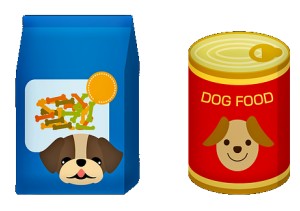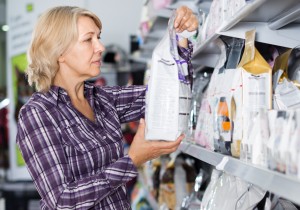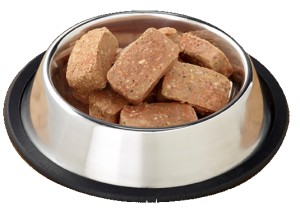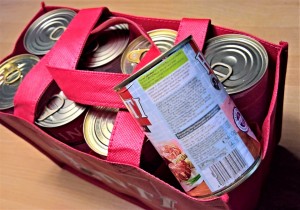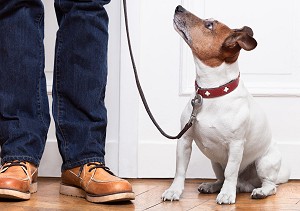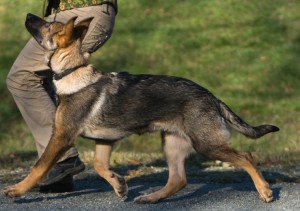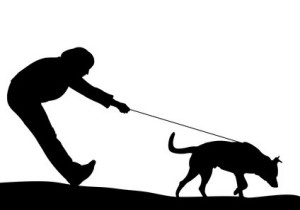A Quick Way To Make Homemade Dog Food
By Michele Welton, Dog Trainer, Breed Selection Consultant, Author of 15 Dog Books
3 Best Ways To Feed Your Dog Healthy Food
What Every Puppy Owner Should Know About Feeding
→ A Quick Way to Make Homemade Dog Food
Pros and Cons of Raw vs Cooked
What Makes a Dog Food Good – or Awful
Truth and Lies on Dog Food Packages
5 Best Kibble and Canned Dog Foods
5 Reasons Not To Feed Your Dog Grains
Two Shocking Reasons Vets Recommend Kibble and Canned Dog Food
How To Tell If Your Dog Is Overweight – And What To Do About It
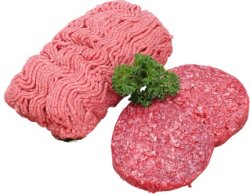
Real meat is the best food for your dog.... nothing else even comes close..... but not just "muscle" meat (pictured above).... your dog also needs organ meat (liver, heart, kidney) and bone.
I think you'll agree with me when I say, "It's really hard to look at all the dog foods out there today and know for sure that you've found the best one for your dog."
Or is it? It turns out you can dramatically increase your dog's chances of living a long, healthy life by making one simple choice. In this post, I'm going to tell you what that choice is... and exactly how to get your dog started on the path to a l-o-o-o-n-g, healthy life.
Cutting right to the chase, the best food for your dog is....
Real food. Real chicken, turkey, beef, bison, venison, fish. Carrots, broccoli, zucchini, pumpkin, apples. Eggs, cottage cheese, plain yogurt.
No, this is not "people food" or "table scraps." Real meat, real veggies, real eggs, etc. are fresh, wholesome, nutritious foods. All living creatures deserve (and thrive on) real food.
Now understand, when I say real food, I'm NOT talking about deli foods like bologna, sliced turkey, or processed cheese. No hot dogs or bacon, or macaroni and cheese. No french fries, pizza, or spicy tacos. That kind of "people food" is terrible for dogs. And honestly, we all know that most of that stuff isn't particularly good for us either!
Feeding real, fresh, whole food will make a huge difference in your dog's future health. That's why a multitude of veterinarians are in full support. World-renowned veterinarian Dr. Martin Goldstein DVM says....
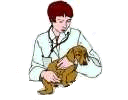 "You can boost your pet's health profoundly by making one simple decision. All you have to do is change his diet from commercial-brand fare to something you may never have imagined giving him – real food."
"You can boost your pet's health profoundly by making one simple decision. All you have to do is change his diet from commercial-brand fare to something you may never have imagined giving him – real food."
Top breeders and trainers have been feeding real food to multiple generations of their dogs.
Veterinarians feed real food, too – that is, veterinarians who refuse to profit from selling dry kibble and canned food.
Vets who ARE still banking those profits might warn you, "Don't feed homemade. You won't know how to balance each meal."
That's nonsense. Each and every meal doesn't need to be balanced. We don't compute the calories and proteins and fats of each and every meal WE eat, do we? We just eat a variety of wholesome foods, and balance occurs over days and weeks.
Same is true for our dogs. You just need to provide overall balance, which looks like this:
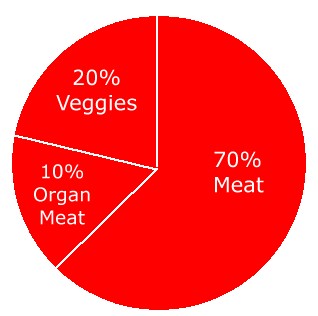
- 70% meat or fish
- 10% organ meat (liver, kidney, spleen)
- 20% vegetables and fruits
- Bone (either attached to the meat, or ground/powdered bonemeal)
If you decide to prepare this meal yourself, my homemade recipe (see below) will tell you how.
Or if you want to feed your dog real food, but don't want to prepare it yourself, check out these frozen/freeze-dried commercial diets.
Homemade dog food recipe
There are 3 steps to making homemade food.
- Decide how much food your dog will need per day.
- Decide how much food to make at one time.
- Make the food.
Let's look at those three steps!
 How much homemade food does your dog need per day?
How much homemade food does your dog need per day?
If your dog is a PUPPY (weighs less than his adult weight), click here for puppy feeding guidelines.
If your dog is an ADULT (has reached his adult weight), he should eat 2-3% of his body weight each day.
More sedentary adult dogs can be fed the lesser percentage, while very active adults can be fed the higher.
The average adult dog usually does best in the middle of the range, about 2.5% of their body weight per day.
| Dog's weight | Amount of food per day |
|---|---|
| 5 lb dog (adult) | 1.5 to 2.5 oz daily – divide into two meals |
| 10 lb dog (adult) | 3 to 5 oz daily – divide into two meals |
| 15 lb dog (adult) | 5 to 7 oz daily – divide into two meals |
| 20 lb dog (adult) | 6.5 to 9.5 oz daily – divide into two meals |
| 25 lb dog (adult) | 8 to 12 oz daily – divide into two meals |
| 30 lb dog (adult) | 9.5 to 14.5 oz – divide into two meals |
| 35 lb dog (adult) | 11 to 17 oz – divide into two meals |
| 40 lb dog (adult) | 13 to 19 oz – divide into two meals |
| 45 lb dog (adult) | 14.5 to 21.5 oz – divide into two meals |
| 50 lb dog (adult) | 1 to 1.5 lbs daily – divide into two meals |
| 75 lb dog (adult) | 1.5 to 2 lbs daily – divide into two meals |
| 100 lb dog (adult) | 2 to 3 lb daily – divide into two meals |
If your dog is between weights, get out your calculator! Multiply his weight by 2% and also by 3%. That will be his range, and again, most dogs do best in the middle.
 For very small breeds (up to 10 lbs), I usually feed the high end of the range (unless they're overweight!). Toy breeds have a faster metabolism that burns through food more quickly.
For very small breeds (up to 10 lbs), I usually feed the high end of the range (unless they're overweight!). Toy breeds have a faster metabolism that burns through food more quickly.- For very large breeds (over 100 lbs), I usually feed the low end of the range, as their metabolism is slower.
Adult dogs should eat two meals a day, so you need to divide the total amount of food into two smaller meals, as shown on the chart. Dogs who eat only once a day experience an empty stomach and may even spit up white froth or bile. Think of how our own stomachs growl and how we feel irritable when we've gone many hours without eating.
 How much food should you make at once?
How much food should you make at once?
You don't need to make your dog's meal and then immediately feed it. You can make up a batch of food (say, 6 meals worth) and store it in the refrigerator for 3 days.
So once you know how much food your dog needs each day, multiply that by 3 days and make up a batch of that amount.
For example, if your 50-pound dog eats 1.5 lbs daily, make up a batch of 4.5 lbs, which will serve him for 3 days (6 meals). All you need to do is take it out of the fridge, scoop a meal's worth into his feeding bowl, and warm it up by floating the bowl in a larger bowl of very hot water. It will quickly warm up to room temperature. Dogs digest food best at room temperature.
For even more convenience, make up a week's worth or 2 weeks worth. Store 3 days worth in the fridge, and freeze the rest. But don't freeze it in one huge chunk – instead, separate it into 3-day quantities in individual freezer bags, so it will be convenient to thaw.
 Homemade dog food recipe
Homemade dog food recipe
There are hundreds of dog food recipes. But honestly, you need only one basic recipe. Then you can swap out the ingredients for variety. That's what I do.
When you first start preparing food for your dog, you should have a good postal or kitchen scale. But don't worry, you'll quickly learn to eyeball the food so that it comes out (roughly) in the right proportions. Perfect accuracy is not required.
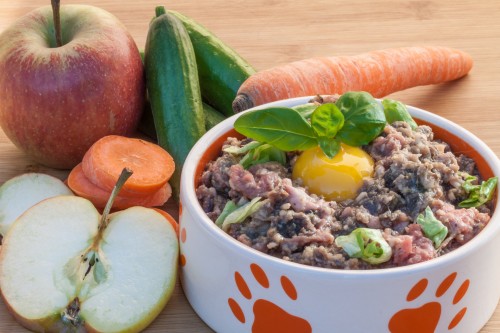
Basic recipe for a homemade diet for dogs
This recipe makes 1 pound (16 ounces) of homemade dog food. For more details, see frequently asked questions below the recipe:
| You need | Preparation | Amount |
|---|---|---|
| Muscle Meat (chicken or turkey breast, ground beef/chicken/turkey, etc) | ground or chopped; lightly sauteed, ideally in coconut oil, or fed raw | 11 oz (that's a little less than 3/4 lb or 1.5 cups) |
| Organ Meat (liver, kidney, spleen...) | ground or chopped; lightly sauteed, ideally in coconut oil, or fed raw | 1 ounce (roughly 2 tablespoons): 50% liver, 50% kidney or spleen |
| Vegetables (broccoli, cauliflower, zucchini, asparagus....) | lightly steamed | 3 oz (a little less than 1/4 lb or 1/3 cup) |
| Fruits (apple, banana, pear...) | chopped, raw | 1 oz (roughly 2 tbsp) |
| Bone meal or calcium | powder | 750mg bone meal (human-grade, not garden-grade) or 600mg plain calcium |
| Fatty acids (for example, salmon oil or powdered flaxseed) | liquid or powder | 10-20mg per day, per pound of body weight |
| Digestive enzymes (only if you're cooking the meat) | powder | follow manufacturer's dosage |
Frequently Asked Questions
Variety is best! Most common are boneless, chopped chicken or turkey breast or thighs; ground beef (hamburger) or ground chicken/turkey; or chunks of stew beef.
You should also try to include bison, venison, lamb, rabbit, and/or duck, from time to time. You can often get these at farmer's markets.
Yes, although most supermarket meat comes from livestock that were raised inhumanely and fed crappy processed corn-based diets, instead of being allowed to free-feed on natural grass. That can affect the quality of the meat.
So if you can find it and afford it, I highly recommend "organic" meat from local, free-range, grass-fed livestock. This is even more important if you're going to feed it raw.
I prefer lean for most dogs. It's easier to keep a meal's overall fat content down if you don't feed fattier cuts of meat.
Yes, although I don't recommend too much fish, because so many species contain toxins such as mercury. We've polluted our oceans, sad to say. The lowest-mercury fish seems to be Wild Alaskan Salmon.
But feeding fish once a week is great. I prefer to cook fish, as cooking kills a particular type of worm in fish that could make a dog sick.
My least favorite part of making homemade food is the organ meat. Organ meat includes liver, kidney, spleen, and "sweetbreads" (pancreas or thymus). Those all sound icky enough, but there are other organ meats (like brains) that even I'm too squeamish to feed.
But dogs need the rich nutrients in organ meat. In fact, organ meat is so rich that dogs should only eat a little bit at a time, else they might get diarrhea.
The most essential organ meat is liver. It's incredibly nutritious, providing iron, B vitamins, minerals, and a huge amount of vitamin A, and yet.... vitamin A can be toxic if your dog gets too much of it, so you mustn't over-do the liver.
Organ meat should make up about 10% of your dog's daily diet. Of that 10%, liver should make up HALF of it. The other half should be one or more of the other organ meats.
Finding organ meat can be tricky. Most large supermarkets carry liver (usually chicken liver or beef liver), so that one's easy. But the other organs may only be available from butchers, farmers' markets, ethnic grocery stores, or online retailers.
Or buy a complete blend of organ meats online: for example, Monster Mash Organ Grind. There are others.
Yes, although technically they don't need vegetables. Vegetables are full of carbohydrates, which have only one purpose in life: supplying energy. But dogs can produce energy from just proteins and fats, so they don't need the carbohydrates from vegetables.
But veggies have other pluses that make me happy to include them in my dogs' diet:
- Vegetables act as roughage. The insoluble fiber in veggies passes through the digestive tract mostly intact, carrying the waste right along with it. Thus veggies help keep the bowels moving. In fact, a dog who catches a rabbit will eat the stomach contents of his prey, which includes digested plants, grasses, and berries. Roughage is good!
- Vegetables contain wonderful phyto-nutrients and anti-oxidants.
- Vegetables are especially useful when your dog needs to lose a little weight because they make him feel full without adding many calories.
The main thing to remember about veggies:
Their nutrients are tucked behind a tough cellulose wall which dogs don't have the enzymes to break down. When a dog eats a prey animal, its stomach contents have already been partially digested so the cellulose wall has been broken down.
So... either pulverize raw veggies in a food processor, or lightly steam/cook them – either of which will break down the cellulose wall so your dog can digest them. Otherwise, veggies may pass through a dog undigested.
Use fresh or frozen veggies, if possible. If you use canned, make sure they're only canned in water, with no salt.
Favorite vegetables are broccoli, cauliflower, zucchini, asparagus, and green beans. Canned pumpkin (not pumpkin pie filling!) helps normalize the stools. (Did you know that pumpkin is technically a fruit, not a vegetable?)
Avoid starchy vegetables such as red or white potatoes, sweet potatoes, yams, butternut squash, and corn. They're fattening and cause blood sugar spikes. Don't feed onion, as it can cause anemia. As can garlic in large quantities, but a little bit of pulverized raw garlic is fine.
Yes, but in moderation. Fruits are sugary and can cause loose stools in some dogs. Especially don't feed canned fruit packed in syrup.
Favorite fruits include slices of apple, pear, banana, or melon. Blueberries and strawberries are usually loved. Many dogs don't like citrus, while others love it.
Like a vegetable, a fruit has a cellulose wall that you should break down before offering it to your dog. Chop the fruit into small pieces (or break small berries in half to expose the nutritious juicy center).
DON'T FEED grapes. Don't feed raisins either, which come from grapes. Grapes and raisins can be toxic to dogs. It usually takes a lot more than a single grape or raisin to make a dog sick, but it doesn't hurt to be cautious.
When a dog eats a rabbit, he eats the meat AND the bone. Not every single bone in the carcass, but lots of small bones. Why?
Because meat is high in a mineral called phosphorus, while bone is high in a mineral called calcium. Since dogs need both minerals in a certain ratio, they instinctively eat both meat and bone.
When living in your home, your dog depends on YOU to give him the right ratio of phosphorus (meat) and calcium (bone). If all you feed is the meat, his body will be forced to pull the calcium it needs from his own bones... making them weaker and more prone to fracturing.
To add calcium, you can either:
- add actual bones to his diet – there are articles on the Internet about how to do this option; I don't do it myself, so am not in a good position to advise
- or add bone meal powder or plain calcium powder
A powdered supplement is a convenient alternative to feeding your dog a real bone.
You can use:
- calcium citrate – a human supplement from your health food store
- or calcium from natural seaweed – Animal Essentials Seaweed Calcium is a good choice
- or bone meal (human-grade! not garden-grade!) – Kal is the most popular brand
When NOT to supplement with bone meal or calcium:
- When you're feeding a commercial diet. The manufacturer has already added the right amount of bone/calcium.
- When you're feeding a commercial diet but you sometimes toss in a little chicken or hamburger, less than 25% of the meal.
With large breed puppies, too much calcium is just as bad as too little. Too much calcium can mess up the rapidly growing bones and joints of a large breed pup. So add just enough to balance the meat, no more.
If you've read anything on human health, you've probably heard about the importance of Omega 3 fatty acids. Our human diet tends to have far too many Omega 6 fats and far too few Omega 3 fats – and that imbalance can lead to chronic health problems.
Same for dogs.
Most doggy diets already have plenty of Omega 6 fats. So usually it's more important to supplement with Omega 3.
Omega 3 fatty acids make your dog's skin and coat shiny and healthy, stop itching, calm stress and anxiety, normalize weight, and prevent or improve inflammatory diseases such as allergies and arthritis.
To provide your dog with these benefits, you can add a commercial Omega 3 supplement such as Zesty Paws Wild Alaskan Salmon Oil (liquid), Grizzly Salmon Oil (liquid), or The Missing Link (powdered). You can even rotate them.
How much Omega 3 does your dog need?
The two essential ingredients in Omega 3 fatty acids are EPA and DHA. Generally, you want to give your dog 10-20mg of EPA+DHA (combined) per pound of his body weight, each day. So if he weighs 50 pounds, he needs 500-1000mg of EPA+DHA per day.
Suppose your bottle of Omega 3 contains, for example, 500mg DHA and 450mg EPA per teaspoon. Add the two together and that bottle contains 950mg EPA+DHA per tsp.
To give your dog his 500-1000mg, you could give him the whole tsp or about half that tsp, and you'd be in the right range for him.
With fatty acid supplements, start LOW and build up, else your dog might get diarrhea.
Important: if your dog is taking any blood thinners, beta blockers, or diuretics, talk to your vet before giving Omega 3 fatty acids.
If you cooked your dog's meat, add digestive enzymes. The canine digestive system was designed for raw food. If you're cooking the food, your dog needs many more stomach enzymes to digest it.
Rather than forcing his pancreas to work overtime making more digestive enzymes, add them yourself.
Otherwise your dog may be gassy or have loose stools. He might even eat his own stools trying to get the nutrients that he missed the first time around because he didn't have enough stomach enzymes to digest them.
Digestive enzymes are a fine white tasteless powder. Popular brands include Prozyme, Animal Essentials, or Dr. Goodpet.
Grains include wheat, corn, soy, barley, millet, rye, quinoa, brown rice, white rice, oats, pasta, and so on.
The short answer is that most dogs shouldn't eat grains on a regular basis. See here for the whys and wherefores.
If you do feed any grain from time to time, I recommend quinoa and oats.
Legumes include peas, lentils, chickpeas, kidney beans, pinto beans, etc.
As with grains, dogs don't have the digestive system needed to properly digest legumes and the result can be intestinal distress and flatulence. But tossing a handful of cooked peas into your dog's meal once in awhile is fine.
However, some human vegetarians use legumes as meat substitutes in their own diets. Don't do that with your dog. There is currently an investigation into whether feeding too many legumes might be triggering a specific form of heart disease in some dogs.
I avoid feeding milk. Just as many people are lactose-intolerant, many dogs end up with soft mucousy stools from cow's milk. Some dogs do better with raw goat's milk, but there really isn't any reason to feed any milk.
Of course, if you're eating ice cream yourself, your dog might appreciate licking the spoon clean. My dogs certainly do!
Most dogs are fine with a little bit of hard cheese, such as mild cheddar or feta.
Cottage cheese is better. Some dog food recipes reduce the quantity of meat and substitute low-fat cottage cheese. If your dog likes it and doesn't get loose stools, it can be a good variety meal once in a while.
Yes, a tablespoon of plain yogurt is good for dogs. It contains "friendly" digestive bacteria (lactobacillus acidophilus), which is good for the digestive tract. Yogurt is especially recommended if your dog has diarrhea or gas. Choose a brand without added sugar.
Yes, eggs are good for dogs and can be given once or twice a week. Look for organic eggs from free-range, pasture-fed hens. Most supermarket eggs come from hens that were raised inhumanely and fed a crappy artificial diet.
You can feed an egg raw or you can soft-boil or lightly scramble it.
Yes, but it's better if it's closer to room temperature.
Obviously don't put RAW food in the microwave to warm it up. Instead, leave raw food on the counter for 15 minutes, or put it in a plastic bag or a smallish dish, and float the bag/dish in a larger bowl of hot water, until it's room temperature.
If you're feeding cooked, I still prefer the methods above, but you can warm that up in the microwave if you're in a hurry.
Foods NOT to give your dog

- Chocolate – can be toxic to dogs
- Grapes – can be toxic to dogs
- Raisins – can be toxic to dogs
- Onions – can cause anemia in dogs
- Garlic – a whole bunch can be toxic to dogs, but a little is fine
- Deli meats (baloney, sliced ham or turkey, pepperoni, etc.) – bad for dogs
- Anything deep-fried or "rich" (gravies or sauces)
- Anything with hot spices
- Anything with a lot of sugar or salt
- Anything alcoholic
- Anything caffeinated (coffee, tea, soda)
MORE ABOUT FEEDING
HONEST ADVICE ABOUT TRAINING
My best-selling books – now available FREE on my website
 Respect Training For Puppies: 30 seconds to a calm, polite, well-behaved puppy is for puppies 2 to 18 months old. Your puppy will learn the 21 skills that all family dogs need to know. Click here to read for free.
Respect Training For Puppies: 30 seconds to a calm, polite, well-behaved puppy is for puppies 2 to 18 months old. Your puppy will learn the 21 skills that all family dogs need to know. Click here to read for free. Teach Your Dog 100 English Words is a unique Vocabulary and Respect Training Program that will teach your adult dog to listen to you and do what you say. Click here to read for free.
Teach Your Dog 100 English Words is a unique Vocabulary and Respect Training Program that will teach your adult dog to listen to you and do what you say. Click here to read for free. 11 Things You Must Do Right To Keep Your Dog Healthy and Happy helps your dog live a longer, healthier life. Get my honest advice about all 11 Things before you bring home your new puppy, because some mistakes with early health care cannot be undone. Click here to read for free.
11 Things You Must Do Right To Keep Your Dog Healthy and Happy helps your dog live a longer, healthier life. Get my honest advice about all 11 Things before you bring home your new puppy, because some mistakes with early health care cannot be undone. Click here to read for free.

